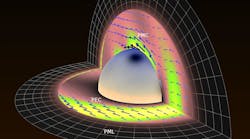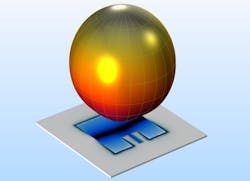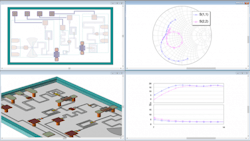The IEEE International Microwave Symposium (IMS) is the high-frequency industry’s largest annual gathering of people and companies, and the 2019 edition is no different. It has attracted over 600 exhibiting companies and tens and thousands of visitors to the Boston Convention and Exhibition Center during this week of June 2-7. Regardless of the needs, solutions can be found on the show floor, from the smallest semiconductor devices to complete systems.
For designers, it’s also an opportunity to enjoy demonstrations of the latest computer-aided-engineering (CAE) software tools, whether the goal is a design for commercial or military audiences. Some CAE software vendors even offer free versions of their software for visitors to try on their own computers. With the growing demands for 5G and automotive electronics, CAE design software for use at millimeter-wave (mmWave) frequencies is becoming even more important.
The latest version of COMSOL Multiphysics (version 5.4) will be running at Booth 136 for visitors interested in the electromagnetic (EM) simulation software (Fig. 1). It features a new Composite Materials Module and COMSOL Compiler for creating standalone simulation applications.
1. The latest version of COMSOL Multiphysics (version 5.4) features more than 40 new substrate materials for frequencies through mmWaves. (Courtesy of COMSOL)
Applications created with the COMSOL Compiler, for example, can be distributed as executable files that can be used without license file restrictions. Improvements in version 5.4 include more than 40 new substrate materials for PCB RF, microwave, and mmWave circuits, full parametric and ready-to-use parts for coils and magnetic cores, and new boundary conditions for thin metallic layers and antireflective coatings. Updates to the RF module include a new microstrip-patch-antenna model with low-profile conformal design and low cost.
ANSYS (Booth 818) is on hand with its powerful EM and three-dimensional (3D) simulation software for two of the most in-demand design areas in the industry: 5G systems and autonomous-vehicle design. The firm offers a complete design solution for creating safer autonomous vehicles using effective radar systems.
The EM simulation software integrates high-fidelity physics with closed-loop simulations of real-world driving, flying, and maneuvering scenarios to validate functional safety. It helps in the development of effective radar systems and sensor integration in the most compact automobile designs to help avoid delays in the path to manufacturing mass-producible safe autonomous self-driving vehicles.
Cadence (Booth 942) is showing the latest version of its popular Cadence Clarity 3D EM field solver software at 2019 IMS. Designers have been looking to design software tools such as this to analyze and better understand critical interconnections in PCBs, systems, and component packages for 5G and autonomous-vehicle applications.
Using distributed multiprocessing technology, the software performs complex calculations without requiring the long processing times of other EM simulators. The software creates accurate S-parameter models for signal-integrity (SI), power-integrity (PI), and electromagnetic-compatibility analysis of complex 3D electronic structures without having to break those structures into much smaller pieces for analysis.
EMWorks (Booth 161) is demonstrating its collection of EM simulation software tools, such as HFWorks, which was created for compatibility with mechanical computer-aided-design (MCAD) software such as Solidworks and SpaceClaim. The EM simulator can even work with free 3D CAD models available on different websites.
The EM simulation software can be used to simulate a wide range of RF/microwave components, including power dividers, filters, connectors, couplers, and oscillators. In addition to standard high-frequency output parameters such as electric and magnetic fields, scattering matrix, impedances, and VSWR, HFWorks can also give you the temperature and temperature gradient due to dielectric and conductor losses. The software is well-suited for simulating components that rely on mechanical as well as electrical configurations, such as microelectromechanical-systems (MEMS) components.
Modelithics (Booth 507), one of the industry’s leading suppliers of high-frequency 3D EM simulation models, is not only be running through a regular schedule of in-booth presentations on its software and models, it’s also conducting contests within the booth for a chance to win $100 in cash. In-booth presentations include simulation software partners such as National Instruments AWR and Keysight Technologies and their Genesys software. The Tuesday afternoon presentation about Keysight Genesys included special guest presenter Chris DeMartino from Microwaves & RF magazine.
For its part, National Instruments (Booth 930) has many of its powerful software design tools on display, including the NI AWR Design Environment, Microwave Office, and the Visual System Simulator (VSS) software. For example, visitors to the AWR site can enjoy a free trial of the Microwave Office circuit design software at any time, or simply stop by the IMS booth to explore some of the powerful capabilities of the CAE suite of software design tools (Fig. 2).
2. Visitors to the National Instruments/AWR booth at the 2019 IMS exhibition can see some of the capabilities of the Microwave Office software design suite. (Courtesy of National Instruments/AWR)
Computer Simulation Technology (Booth 824) offers up demos of its many different EM simulation software tools at the exhibition, including Antenna Magus and the CST Studio Suite 3D EM analysis software. Antenna Magus helps increase design efficiency by providing a design engineer with an educated starting point on a choice of antenna element for a high-frequency design. Validated antenna models can be exported from the Antenna Magus to the CST Studio Suite from an antenna database of over 330 antennas, helping to speed the antenna design process.
The CST Studio Suite provides the means of designing, analyzing, and optimizing EM circuits and components. Its powerful EM field solvers can be used in hybrid simulations to analyze system-level designs based on many different types of components. The software is a popular tool for the design and optimization of antennas and filters and for performing electromagnetic-compatibility (EMC) and electromagnetic-interference (EMI) analysis on different components. It’s also been used to study the thermal effects in high-power EM devices, allowing for the miniaturization of components even when operating at high power levels.



